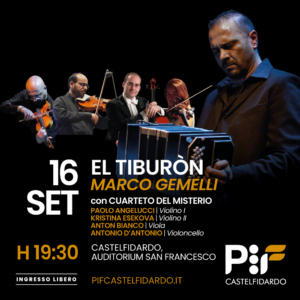EL TIBURÒN with Marco Gemelli
and Paolo Angelucci (Violino I)
Kristina Esekova (Violino II)
Anton Bianco (Viola)
Antonio D’Antonio (Violoncello)
September16th, 2023 – 7,30 pm
Castelfidardo, Auditorium San Francesco
For more information, write to info@pifcastelfidardo.it or call 071 7822987.
EL TIBURÒN constitutes a wonderful rereading of the proposed pages, an enrichment, a renewal… in the renewal, thanks to the accompaniment of the Cuarteto Del Misterio composed with Paolo Angelucci (Violin I), Kristina Esekova (Violin II), Anton Bianco (Viola) and Antonio D’Antonio (Cello).
Astor Piazzolla had a sanguine and determined character. This is why he had become passionate about shark fishing, an activity that is anything but relaxing, which on the contrary puts adrenaline into circulation. And if pescar un tiburón es un desafío (fishing a shark is a challenge), it is just as much, much more compelling, to make a revolution in Tango. To do this, Piazzolla put all his determination into play together with a great ability to never give up, since, in this process of reform, there have been no shortage of difficult moments. Eventually he succeeded, renewed the tango and became an internationally acclaimed musician. Notoriously, the turning point in his career was his meeting with the great French teacher Nadia Boulanger, so from this we can deduce that Piazzolla’s reform process began in 1955. Precisely in that year while he was in Puerto Rico for a tour, he is given the news of the death of Vincente, his father. Astor, out of hilarity, had always mocked his parents’ majority calling them Nonino and Nonina. Back in New York, after having reunited with his loved ones, he locks himself in a room and writes the famous Adiós Nonino in one go. This piece lives on the contrast of the two themes, the first more severe and regular based on the rhythm of the traditional tango, the second slower and more lyrical based on what Piazzolla will consolidate as the rhythmic cell of the Nuevo Tango, the 3+3+2. But inside Adiós Nonino there is more, there is the contrast between generations, between styles, between different timbral groupings and among the many contradictions of his beloved Argentina. In his career he produced several arrangements of this piece and in the last years before his death, this piece was rarely missing from his concerts. The central body of this record by Marco Gemelli is made up of some very important pages that Piazzolla composed for the Quinteto Nuevo Tango (a formation that consisted of  bandoneon, violino, chitarra elettrica, pianoforte e contrabbasso); after the aforementioned Adiós Nonino, here they are listed by year of composition: 1962 Muerte del Ángel, 1965 Milonga del Ángel, 1965 Verano porteño, 1969 Otoño porteño, 1970 Invierno porteño and Primavera porteña (therefore 1970 is the year in which the cycle of Cuatro estaciones porteñas) and in 1971 the Concierto para quinteto. The pieces Muerte del Ángel and Milonga del Ángel together with Introducción del Ángel and the Resurrección del Ángel, constitute the so-called Suite dedicated to the Ángel. These two compositions generate an incredible wealth of contrasts and opposing elements: grit against melancholy, rhythm against melody, vehemence against intimism. La Muerte del Ángel is famous for its initial fugato and impetuous finale; Milonga del Ángel is considered one of the most successful slow tempo melodies among Piazzolla’s compositions. Admiration for the great composers of history is probably the basis of Piazzolla’s idea of writing four pieces dedicated to the seasons. But the richness of contrasts that make up the essence of these four pieces is already revealed in the title: if Cuatro estaciones makes you think of the world of classical music, as you add the adjective porteñas you whirl into the world of tango and one of its elements that make up its culture: the port. A year later, yet another page arrives to increase the already significant amount of work produced by the Quinteto: the Concierto para Quinteto, which is dedicated by Piazzolla to his musicians, to his companions of over 10 years of intense work. Cafè 1930 and Nightclub 1960 are excerpts from the collection Histoire du Tango originally written for flute and guitar. It was the Liège Guitar Festival that commissioned this work to Piazzolla in 1985, who wanted to reserve this collection to these two instruments, present in the primordial phases of the Rioplatense tango around 1880 (actually alongside other instruments such as violin and harp) . Cafè 1930 and Nightclub 1960 are the second and third tracks of the series, preceded by Bordel 1900 and followed by Concert d’aujourd’hui. Cafè 1930 refers a bit to the tango-canción period, i.e. the most nostalgic and romantic period in the history of tango. Nightclub 1960 fully recalls the transformation of the tango carried out by Piazzolla, with its diffusion to a wider and also international audience. To conclude, a question naturally arises: is it possible to render the essence of Piazzolla’s music with a different ensemble than the one originally thought by the author? Absolutely yes; Astor Piazzolla’s compositions lend themselves very easily to adaptations, arrangements, revisions, etc. Of course, to have good results you need the mastery of those who take care of the arrangements together with the mastery of the performers, and Marco Gemelli with the string quartet formed by Paolo Angelucci, Kristina Esekova, Stefano Morgione and Alessandro Lumachi demonstrated in an extraordinary way their ability to capture the essence of Piazzolla’s music. For this reason their work constitutes a wonderful re-reading of the proposed pages, an enrichment, a renewal… within the renewal. Yes, because we must not forget that the shark fisherman was an inveterate “renewale”.
bandoneon, violino, chitarra elettrica, pianoforte e contrabbasso); after the aforementioned Adiós Nonino, here they are listed by year of composition: 1962 Muerte del Ángel, 1965 Milonga del Ángel, 1965 Verano porteño, 1969 Otoño porteño, 1970 Invierno porteño and Primavera porteña (therefore 1970 is the year in which the cycle of Cuatro estaciones porteñas) and in 1971 the Concierto para quinteto. The pieces Muerte del Ángel and Milonga del Ángel together with Introducción del Ángel and the Resurrección del Ángel, constitute the so-called Suite dedicated to the Ángel. These two compositions generate an incredible wealth of contrasts and opposing elements: grit against melancholy, rhythm against melody, vehemence against intimism. La Muerte del Ángel is famous for its initial fugato and impetuous finale; Milonga del Ángel is considered one of the most successful slow tempo melodies among Piazzolla’s compositions. Admiration for the great composers of history is probably the basis of Piazzolla’s idea of writing four pieces dedicated to the seasons. But the richness of contrasts that make up the essence of these four pieces is already revealed in the title: if Cuatro estaciones makes you think of the world of classical music, as you add the adjective porteñas you whirl into the world of tango and one of its elements that make up its culture: the port. A year later, yet another page arrives to increase the already significant amount of work produced by the Quinteto: the Concierto para Quinteto, which is dedicated by Piazzolla to his musicians, to his companions of over 10 years of intense work. Cafè 1930 and Nightclub 1960 are excerpts from the collection Histoire du Tango originally written for flute and guitar. It was the Liège Guitar Festival that commissioned this work to Piazzolla in 1985, who wanted to reserve this collection to these two instruments, present in the primordial phases of the Rioplatense tango around 1880 (actually alongside other instruments such as violin and harp) . Cafè 1930 and Nightclub 1960 are the second and third tracks of the series, preceded by Bordel 1900 and followed by Concert d’aujourd’hui. Cafè 1930 refers a bit to the tango-canción period, i.e. the most nostalgic and romantic period in the history of tango. Nightclub 1960 fully recalls the transformation of the tango carried out by Piazzolla, with its diffusion to a wider and also international audience. To conclude, a question naturally arises: is it possible to render the essence of Piazzolla’s music with a different ensemble than the one originally thought by the author? Absolutely yes; Astor Piazzolla’s compositions lend themselves very easily to adaptations, arrangements, revisions, etc. Of course, to have good results you need the mastery of those who take care of the arrangements together with the mastery of the performers, and Marco Gemelli with the string quartet formed by Paolo Angelucci, Kristina Esekova, Stefano Morgione and Alessandro Lumachi demonstrated in an extraordinary way their ability to capture the essence of Piazzolla’s music. For this reason their work constitutes a wonderful re-reading of the proposed pages, an enrichment, a renewal… within the renewal. Yes, because we must not forget that the shark fisherman was an inveterate “renewale”.

